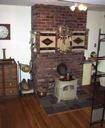|
Arting of the fire and the heating of the room. Sizing Some manufacturers rate their stoves in terms of cubic feet they will heat; others use number of rooms; a few use Btu (British thermal units). Unless you know the conditions the stove was tested under and how these compare to your own situation, most ratings are of little value. At best, ratings should be used only as general guides. Selecting a size based on space available and required clearances around the stove or on capacity to handle the size fuel you have may be more important than rating. Placing the stove Stove placement is usually determined by location of an existing chimney flue or by the potential chimney location. The stove should be located as close as possible to the chimney inlet. Maximum length of stovepipe connecting the stove to the chimney should not exceed 8 to 10 feet, and the pipe should have no more than two 90-degree elbows. Since wood stoves are seldom designed with positive circulation systems, locate th
installation stove wood Sked Jan Herald installation stove wood, a director with WETT (Wood Energy Technology Training) what to watch for in wood stove installation. She brought the Marketplace cameras to a bungalow being built near Shelburne installation stove wood, Ontario. A WETT certified contractor is installing a wood stove. Herald told us the ideal location for a wood stove in this particular house is the living room. "It's totally open installation stove wood, " she pointed out. "We couldn't have a better location for the chimney. In order for this stove to perform at its best we want to keep the chimney as warm and as straight as we can." The stovepipe installation stove wood, Herald notes installation stove wood, is critical. A do-it-yourself-er might neglect to use a double-walled stovepipe installation stove wood, opting for a cheaper single walled pipe. "Galvanized stove pipe is a very common thing and galvanized stove pipe is a dangerous thing to use installation stove wood, " Herald cautioned. "It's commonly available in hardware stores and people who don't know what they're looking for will see it as stovepipe and take the wr installation stove wood.
installation stove wood Ennis-Sparrer installation stove wood, Lanexa installation stove wood, VA There's a lot of helpful information here on our website. There is also some great free information available by simply requesting the Free Information Pack and Video. In addition to helpful information and lots of product photos installation stove wood, you'll also receive special offers that can save you money! Current Sale Information Reserve Your Stove click here Useful Information for prospective or existing stove owners Woodstove Information Woodstove Installation Guide What Makes a Good Chimney Masonry Chimneys Prefabricated Chimney Adjustable Stovepipe Which End is Up? How to Install Stovepipe Correctly How Many BTU's Do You Need Wood Burning Basics Why Burn Wood? Handy Downloads Cures for backpuffing Delivery Guide Gas Stove Information Gas Stove Preliminary Installation Guide(pdf) 6 Ways To Install Your Direct Vent Gas Stove Why We Don't Do Ventless Catalytic Combustor Tips Click here to Download a pdf Wood Stove Brochure Click here to Download a pdf Gas Stove Brochure Ques.
installation stove wood Along the top of shield at ceiling: 75 mm (3 in.). Shield extension beyond each side of appliance: 450 mm (18 in.). Shield extension above appliance: 500 mm (20 in.). Edge clearance for ceiling shields: 75 mm (3 in.). Adhesives used in shield construction must not ignite or lose adhesive qualities at temperatures likely to be encountered. Mounting hardware must allow full vertical ventilation. Mounting hardware must not be located closer than 200 mm (8 in.) from the vertical centre line of the appliance. Mounting hardware which extends from the shield surface into combustibles may be used only at the lateral extremities of the shield. Commercial shields are also available for the reduction of minimum clearances. These shields are subjected to a series of tests to determine how effectively they can reduce clearances. They are certified and carry a label which confirms that they have met the tests and provides information on clearance reduction details. Some of these commercial shields a.
installation stove wood 
installation stove wood | | | | | |
installation stove wood
Etal over 1 4-inch layer of non-combustible board 6 inches or less 4 inches of hollow masonry laid to provide air circulation through the masonry layer covered by a sheet of 24-gauge sheet metal Extent of protection is: 18 inches beyond any side with a firebox opening (door) 12 inches beyond all sides with no openings The innermost lining of the chimney should be stainless steel to withstand high temperatures and corrosive environment. Install only a class A, all-fuel, or solid-fuel chimney for a wood stove installation. There are three common types of listed factory-built metal chimneys; all are equally safe when installed in accordance with instructions and properly maintained. The three types are: 1) the air cooled thermo-syphon chimney, 2) solid pack insulated chimney and, 3) air insulated chimney. Wood stoves function more efficiently with less maintenance problems when using a solid pack or air insulated chimney. The thermo-syphon chimney is designed principally for use with fire
|


